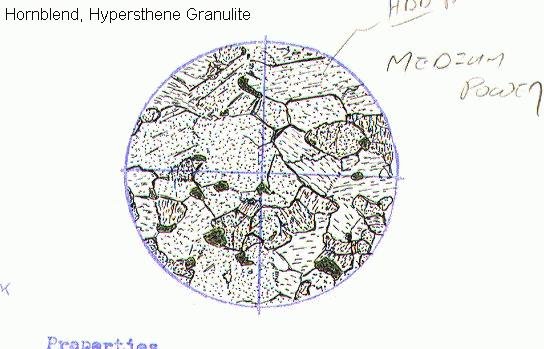Hornblend Hypersthene Granulite

The sample here contains essentially all hypersthene with minor relict hormblend seen with its green tone. Hornblende and hypersthene have basically the same chemical formula with hornblend having some water in its structure and a more open crystal lattice. Hypersthene by contrast has a compact and more dense structure and lacks any water. As conditions progress with increasing burial and tectonic pressure the hornblende will recrystallize, release what water is there and form hypersthene in compact granulitic texture.
Metamorphic rock naming convention: first minor or accessory minerals, second main rock-forming minerals, thirdly rock texture, (geniss or granulite in my case).
My Master's Thesis consisted of mapping, collecting, studying, and analysing numerous rock types from a small area of Southwest Montana. The analysis revealed the area to be an ancient terrain formed originally as sediments deposited in an open marien shelf setting prior to 2.8 billion years ago. By 2.8 Billion Years ago the section had already been very deeply buried in an active tectonic zone. The original sediments, under extreme conditions of temperature and pressure, were folded and changed, the crystals growing new minerals stable under the conditions, and resetting geolgic clock to that event. The section has largely remained stable from that time until recent. At about 1.6 Billion years the region was uplifted and the unroofing caused some retrograde mineral changes and certain areas adjusted to conditions lf lower temperature and pressure. In my thesis area the mineralogy largly escaped this event, probably due to the extreme dryness of the minerology. Ions simply were unable to migrate and reform new minerals.
My study was to document these ancient events and to determine, via study of the minerology, the conditions of temperature and pressure under which these minerals originally formed and to find evidence, if possible, of the original sedimentary nature of the section.
kjs
For those interested in the bitter detail on the petrology and origin of Gneiss and associated rocks, at least from one specific ancient locality, see my
Master's Thesis....
Go back....

